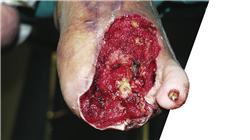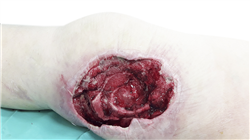University certificate
The world's largest faculty of nursing”
Introduction to the Program
Through this 100% online Postgraduate diploma, you will recognize early signs of skin lesion complications, allowing for faster interventions”

A report published by the World Health Organization estimates that approximately 15% of hospitalized patients and 70% of users develop Pressure Ulcers at some point during their stay. These injuries not only prolong hospitalization and increase health care costs, but can also lead to serious complications such as systemic infections and functional impairment. Therefore, effective management of these conditions requires a comprehensive approach, including systematic risk assessment, robust preventive strategies and evidence-based treatments.
In this context, TECH implements a pioneering Postgraduate diploma in Dependency-Related Skin Injuries. The academic itinerary will delve into the evaluation of Skin Wounds, which will allow professionals to correctly diagnose the lesions presented by patients and determine the most appropriate treatments immediately. Likewise, the syllabus will delve into the most advanced therapies for wound care, among which Negative Pressure Therapy, Hyperbaric Oxygen or Laser Therapy stand out. On the other hand, the didactic materials will delve into the cleaning of skin lesions associated with Dependency. In this way, graduates will eliminate pathogenic microorganisms and reduce the risk of wound infection.
On the other hand, in terms of methodology, the program is taught 100% online, giving patients the opportunity to access the content from anywhere and at any time, adapting the study to their schedules. In addition, TECH employs its revolutionary learning method: Relearning.
This system consists of the repetition of key concepts to fix knowledge and facilitate long-lasting learning. In addition, the program will feature the participation of a renowned International Guest Director, who will offer several master classes to delve into the latest advances in the treatment of Dependency-Related Skin Lesions .
A renowned International Guest Director will give rigorous Masterclasses to delve into the latest innovations in the approach to Dependency-Related Skin Lesions ”
This Postgraduate diploma in Dependency-Related Skin Lesions contains the most complete and up-to-date scientific program on the market. The most important features include:
- The development of practical cases presented by experts in Wound Care for Nursing
- Graphic, schematic, and practical contents which provide scientific and practical information on the disciplines that are essential for professional practice
- Practical exercises where the self-assessment process can be carried out to improve learning
- Its special emphasis on innovative methodologies
- Theoretical lessons, questions to the expert, debate forums on controversial topics, and individual reflection assignments
- Content that is accessible from any fixed or portable device with an Internet connection
You will delve into Wound Care in a Moist Environment, which will help wounds heal faster”
The program’s teaching staff includes professionals from the sector who contribute their work experience to this specializing program, as well as renowned specialists from leading societies and prestigious universities.
The multimedia content, developed with the latest educational technology, will provide professionals with situated and contextual learning, i.e., a simulated environment that will provide immersive specialization, designed for specializing oneself in real situations.
This program is designed around Problem-Based Learning, whereby the professional must try to solve the different professional practice situations that arise during the course. For this purpose, students will be assisted by an innovative interactive video system created by renowned and experienced experts.
Do you want to incorporate into your daily practice the most effective pharmacological strategies to reduce diabetic foot pain? Achieve it through this program in only 540 hours"

You will reinforce your key knowledge through TECH's innovative Relearning methodology, achieving an effective assimilation of the subject"
Why study at TECH?
TECH is the world’s largest online university. With an impressive catalog of more than 14,000 university programs available in 11 languages, it is positioned as a leader in employability, with a 99% job placement rate. In addition, it relies on an enormous faculty of more than 6,000 professors of the highest international renown.

Study at the world's largest online university and guarantee your professional success. The future starts at TECH”
The world’s best online university according to FORBES
The prestigious Forbes magazine, specialized in business and finance, has highlighted TECH as “the world's best online university” This is what they have recently stated in an article in their digital edition in which they echo the success story of this institution, “thanks to the academic offer it provides, the selection of its teaching staff, and an innovative learning method aimed at educating the professionals of the future”
A revolutionary study method, a cutting-edge faculty and a practical focus: the key to TECH's success.
The most complete study plans on the university scene
TECH offers the most complete study plans on the university scene, with syllabuses that cover fundamental concepts and, at the same time, the main scientific advances in their specific scientific areas. In addition, these programs are continuously being updated to guarantee students the academic vanguard and the most in-demand professional skills. In this way, the university's qualifications provide its graduates with a significant advantage to propel their careers to success.
TECH offers the most comprehensive and intensive study plans on the current university scene.
A world-class teaching staff
TECH's teaching staff is made up of more than 6,000 professors with the highest international recognition. Professors, researchers and top executives of multinational companies, including Isaiah Covington, performance coach of the Boston Celtics; Magda Romanska, principal investigator at Harvard MetaLAB; Ignacio Wistumba, chairman of the department of translational molecular pathology at MD Anderson Cancer Center; and D.W. Pine, creative director of TIME magazine, among others.
Internationally renowned experts, specialized in different branches of Health, Technology, Communication and Business, form part of the TECH faculty.
A unique learning method
TECH is the first university to use Relearning in all its programs. It is the best online learning methodology, accredited with international teaching quality certifications, provided by prestigious educational agencies. In addition, this disruptive educational model is complemented with the “Case Method”, thereby setting up a unique online teaching strategy. Innovative teaching resources are also implemented, including detailed videos, infographics and interactive summaries.
TECH combines Relearning and the Case Method in all its university programs to guarantee excellent theoretical and practical learning, studying whenever and wherever you want.
The world's largest online university
TECH is the world’s largest online university. We are the largest educational institution, with the best and widest online educational catalog, one hundred percent online and covering the vast majority of areas of knowledge. We offer a large selection of our own degrees and accredited online undergraduate and postgraduate degrees. In total, more than 14,000 university degrees, in eleven different languages, make us the largest educational largest in the world.
TECH has the world's most extensive catalog of academic and official programs, available in more than 11 languages.
Google Premier Partner
The American technology giant has awarded TECH the Google Google Premier Partner badge. This award, which is only available to 3% of the world's companies, highlights the efficient, flexible and tailored experience that this university provides to students. The recognition as a Google Premier Partner not only accredits the maximum rigor, performance and investment in TECH's digital infrastructures, but also places this university as one of the world's leading technology companies.
Google has positioned TECH in the top 3% of the world's most important technology companies by awarding it its Google Premier Partner badge.
The official online university of the NBA
TECH is the official online university of the NBA. Thanks to our agreement with the biggest league in basketball, we offer our students exclusive university programs, as well as a wide variety of educational resources focused on the business of the league and other areas of the sports industry. Each program is made up of a uniquely designed syllabus and features exceptional guest hosts: professionals with a distinguished sports background who will offer their expertise on the most relevant topics.
TECH has been selected by the NBA, the world's top basketball league, as its official online university.
The top-rated university by its students
Students have positioned TECH as the world's top-rated university on the main review websites, with a highest rating of 4.9 out of 5, obtained from more than 1,000 reviews. These results consolidate TECH as the benchmark university institution at an international level, reflecting the excellence and positive impact of its educational model.” reflecting the excellence and positive impact of its educational model.”
TECH is the world’s top-rated university by its students.
Leaders in employability
TECH has managed to become the leading university in employability. 99% of its students obtain jobs in the academic field they have studied, within one year of completing any of the university's programs. A similar number achieve immediate career enhancement. All this thanks to a study methodology that bases its effectiveness on the acquisition of practical skills, which are absolutely necessary for professional development.
99% of TECH graduates find a job within a year of completing their studies.
Postgraduate Diploma in Dependency-Related Skin Lesions
Discover TECH Global University's Postgraduate Diploma in Dependency-Related Skin Lesions, a unique opportunity for nurses who wish to specialize in the advanced management of dermal lesions in dependent patients. This innovative program offers online classes designed to provide fundamental theoretical and practical knowledge, guided by experts in the field of specialized nursing. Today, skin injuries, such as pressure ulcers, represent a significant challenge in the care of dependent patients. These conditions not only affect the patient's quality of life, but also their overall well-being. Therefore, it is crucial that nursing professionals are properly specialized to prevent, identify and effectively treat these injuries. This Postgraduate Diploma program combines the flexibility of online classes with a rigorous focus on the latest clinical practices and protocols. Participants will learn advanced strategies for risk assessment, selection of appropriate treatments and promotion of wound healing, all based on up-to-date scientific evidence.
Study at the best digital university
Do you know why TECH is considered one of the best universities in the world? Because we have a catalog of more than ten thousand academic programs, presence in multiple countries, innovative methodologies, unique academic technology and a highly qualified faculty; that's why you can't miss the opportunity to study with us. Upon completion of this postgraduate diploma, graduates will be prepared to face the specific challenges of skin injuries in long-term care and hospital settings. In addition, they will acquire skills that will not only benefit their patients, but also strengthen their professional development in the skilled nursing field. Don't miss this opportunity to advance your career and become an expert in the management of dependency-related skin injuries - enroll in TECH Postgraduate Diploma in Skin Injuries at TECH Global University of Technology today and make a difference in healthcare!







